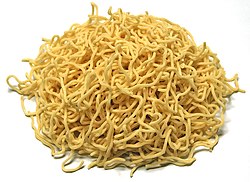 Fresh ramen | |
| Type | Noodles |
|---|---|
| Place of origin | Japan |
| Main ingredients | Flour, water |



Noodles are a staple of Japanese cuisine. They are often served chilled with dipping sauces, or in soups or hot dishes. [1] Noodles were introduced to Japan from China during the Song Dynasty between the Heian until the early Kamakura period.